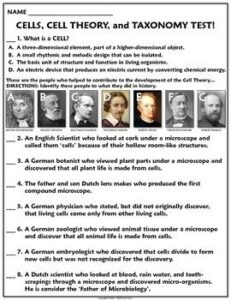“Cells–Necessary for Life?” is a handout that records your answers and can be found under Related Items. Life on Earth is diverse, and every species has specific roles within ecosystems. Cells, however, are the building blocks of all life on Earth. Find out more about these important building blocks and how they affect life. It is also helpful to look up other related terms, such as ATP synthesizing and the Nucleus.
Tenets
There are four widely accepted tenets of cell theory. The first states that all organisms are made up of cells, and that all living cells originate from pre-existing ones. The second tenet states that cells are similar and arise from pre-existing ones. However, it’s possible that some biologists disagree, and believe that non-cellular entities are living and can reproduce. In any case, the cell theory is an important concept in understanding life on earth.
Cell theory is a foundational principle in biology. Everything you learn in science class has some connection to the cell theory. This guide explains the definition of cell theory, key dates in the development of cell theory, and the importance of this concept. Cells are the basic units of structure and function of all living things. Living cells originate from pre-existing ones and are derived from them through a process of cell division.
Nucleus
There are many theories concerning the nucleus of cells. Some scientists dispute the idea that cells are essentially shell-like structures. Some believe that cells are elongated, while others say that the nuclei are round or star-like. Some scientists even question whether cells came from another planet. Whatever the case, cell origin theories are still an important part of science education. Listed below are some of the most common questions that scientists may ask about cells.
The Nucleus of Cell Theory: What Is It? Although the cell’s nucleus is mostly transparent and colorless, scientists can’t see it without special equipment. To view it, scientists use a special dye. Most cell images of cells contain a blue nucleus. It’s important to note that the processes described in cell theory aren’t universal, though. Rather, they are specific to different kinds of cells.
Organelle
In cell theory, an organelle is a subcellular structure with a specific job. In contrast to organs, which are separate parts of the body, organelles are microscopic subunits within cells that perform specific functions. Organelles are typically membrane-bound and contain distinct functions. They can also be called vesicles. They perform different functions in the cell and are important in many aspects of life. Read on to learn more.
Recognition of organelles depends on the tools and observations used in science. The light microscope was the first important tool. Cells were also observed in plant material, making observation of organelle biogenesis easier. Substances such as cellulose made it possible to see organelles of unicellular organisms. A more thorough understanding of organelle biogenesis is currently needed in order to improve the way cells function. Until then, however, organelles were merely assumed to be stationary and amorphous.
ATP synthesizing
One of the fundamental questions in ATP synthesizing cell theory is the exact mechanism used to produce ATP. All living cells have a rotary ATP synthase, which is more efficient than other mechanisms, which pass protons one at a time. This elaborate mechanism may have emerged during evolution from simpler alternating-access mechanisms. However, it is not completely clear why evolution selected this elaborate mechanism.
In the case of the plant cell, the F-ATPase is believed to use an alternating-access mechanism to generate the electrochemical potential needed for ATP synthesis. While the F-ATPase transports eight to fifteen protons per 360-degree rotation, the amount of protons transported depends on the type of cell and organelle. The FE change depends on the type of membrane and pH difference, but the kinetic behavior should be nearly equivalent under physiological conditions.
Toxins
Toxins work by making specific cuts in the ribosomal RNA in their target cell. When this cut occurs, the cell stops producing protein and dies. In addition, bacteria produce inhibitor proteins to prevent toxin action. The toxin proteins are known as CDI toxins. The PSI researchers solved the structures of the CDI toxin. The CDI toxin is composed of a large protein with a connector segment, which binds to receptors on target cells. The toxin domain then cleaves the connector segment and forces its way into the target cell.
Shiga toxin is an example of a toxin that clusters on the cellular plasma membrane. Despite the clustering observed, the mechanism by which the Shiga toxin clusters is still unknown. This mechanism has been studied using vesicle systems and computer simulations. Simulations have shown that line tension cannot be the primary force driving Shiga toxin clustering.

Viruses
Cell theory does not include viruses, which are not considered to be cells at all. Cells are the basic units of life in all organisms. While all living things have cells, viruses do not have a cell membrane or nucleus and do not use cells in any process. All living cells derive their existence through division, but viruses do not use cell membranes or cells in any process. Various researchers have made important contributions to cell theory, including Matthias Schleiden, Theodor Schwann, and Rudolf Virchow.
Viruses need host cells in order to reproduce. They are made up of nucleic acids that are enclosed in a protein coat. The coat may also shelter the viral proteins that carry out infection. Once inside a cell, a virus does not remain inactive, but sheds its coat and bares its genes. The virus then stimulates the cell’s replication machinery, which then reproduces its nucleic acid and produces viral proteins based on it. These newly produced bits of virus assemble into more virus.

